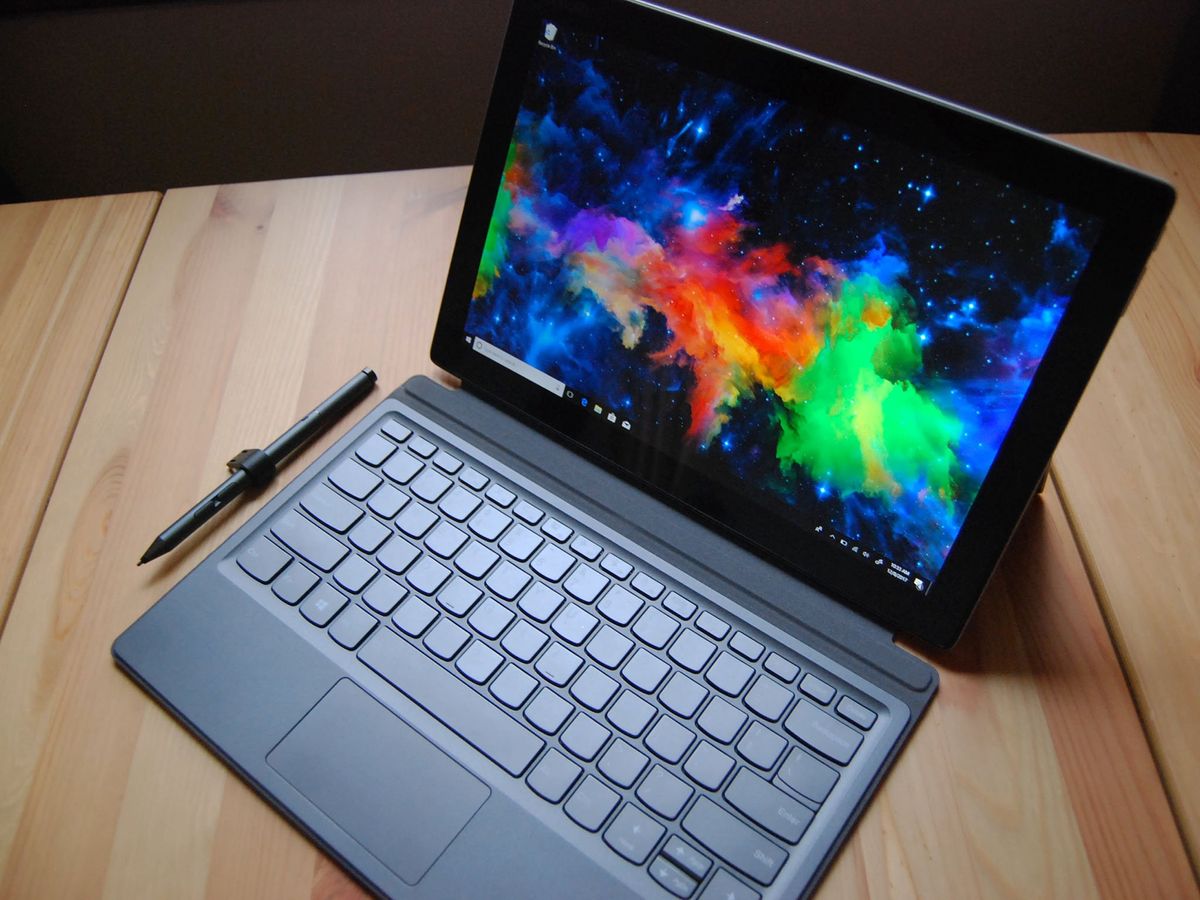
As the mid-range option of Lenovo's Miix line, we're getting here some brand new hardware that's perfect for multi-tasking and productivity. It doesn't have as many features as the Miix 720, but it's certainly a fine 2-in-1. Here's our review.
About this review
Lenovo loaned Windows Central a review unit of the 12.2-inch Miix 520. This specific configuration has an eighth-generation Intel Core i5-8250U processor (CPU), 8GB of DDR4-2133MHz RAM, and a 256GB PCIe solid-state drive (SSD). This exact configuration costs about $1,000.
Lenovo Miix 520 hardware and specifications

| Category | XX |
|---|---|
| Processor | Intel Core i5-8250U (up to 3.40GHz)Quad-core |
| Storage | 256GB PCIe SSDSamsung PM961 |
| RAM | 8GB DDR4-2133MHz |
| Display | 12.2-inch FHD (1,920 x 1,200)IPS, touch, glossy |
| Graphics | Intel UHD Graphics 620 |
| Ports | USB-CUSB-A 3.03.5mm jackMicro SIM |
| Audio | Dual stereo speakersDolby Audio |
| Wireless | Intel Dual Band Wireless-AC 8265802.11ac (2 x 2)Bluetooth 4.1 |
| Camera | Front-facing 5MPRear-facing 8MP |
| Keyboard | Magnetic attachable |
| Touchpad | Precision touchpad |
| Pen | Lenovo Active Pen 2 |
| Battery | Two-cell 39WHr |
| Weight | Tablet only: 1.98 pounds (0.9kg)With keyboard: 2.65 pounds (1.2kg) |
| Dimensions | Tablet only: 11.8 inches x 8.1 inches x 0.4 inches300mm x 205mm x 9.9mmWith keyboard: 11.8 inches x 8.1 inches x 0.6 inches300mm x 205mm x 15.9mm |
| OS | Windows 10 Home |
| Price | Starting at $1,000 |
Lenovo Miix 520 design
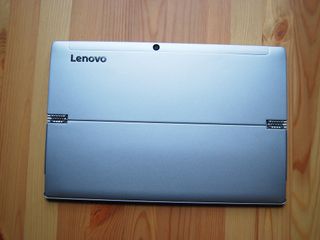
The Miix 520 is built from a sturdy aluminum-alloy chassis that weighs just under two pounds (0.9kg) and is less than a half-inch thick. It's got the weight of a tablet and is easy to hold, and it certainly fits into most bags quite easily, even with the keyboard attached adding an extra 0.2 inches to thickness and just over a half-pound of weight.
Borrowing from the Yoga-920, the kickstand on the back of the tablet has two small watchband hinges that offer a smooth action that will hold your device in place, even while using a pen with it laid out almost flat. You get about 150 degrees of kickstand range here, which is about 15 degrees less than found with the Surface Pro. Still, the angle is comfortable when using the Active Pen 2.
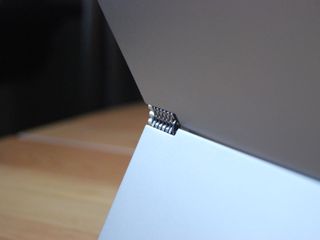
Radial vents along the side and top of the chassis provide cooling that doesn't get blocked by your lap, and a speaker is housed near the bottom edge on either side. They aren't placed in the indent that allows for easy kickstand deployment, but they nevertheless remain unmuffled most of the time. I don't expect much from tablet speakers, but these were surprisingly loud and full. On the back, hidden behind the kickstand, is a Micro SIM slot of you go with optional LTE connectivity.


The right side of the tablet has a physical power button, volume toggle, and 3.5mm audio jack. Set near the top corner, the power button isn't in a spot where you'll occasionally hit it accidentally when using the tablet. The left side has a charging port as well as a USB-A 3.0 and USB-C port. It's enough to plug in a mouse (and more with the right adapters), which you might be tempted to do once you try using the tiny touchpad.
Get the Windows Central Newsletter
All the latest news, reviews, and guides for Windows and Xbox diehards.
Lenovo Miix 520 display
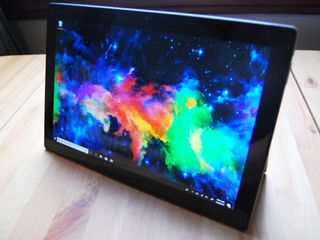
The 12.2-inch touch display doesn't have as high of a resolution as the Miix 720 — here it's 1,920 x 1,200 compared to 2,880 x 1,920 — but it's nevertheless a crisp picture with decent contrast. Testing color accuracy, we saw 91 percent sRGB and 72 percent AdobeRGB, both respectable results.
There's plenty to hold onto thanks to the chunky bezel around the display. If you're someone who likes the look of a screen that stretches edge to edge, you could do better elsewhere. There's plenty of room for a front-facing, 5MP webcam above the display; the picture is clear enough for video conferencing and doesn't take bad stills, but there's always the rear-facing, 8MP camera if you'd like higher quality shots.

Lenovo's Active Pen 2 comes included with the Miix 520, delivering a satisfactory inking experience at 4,096 levels of pressure sensitivity. The pen is a great size to fit in your hand comfortably and, while there's still no tilt support for shading, I didn't have a problem jotting down notes and marking up articles. My main gripe, and one that I've pointed out before is the plastic attachment piece that makes you use a USB-A port to store your pen.
Lenovo Miix 520 keyboard and touchpad
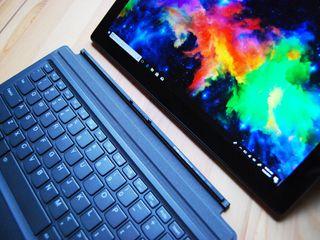
The removable keyboard attaches magnetically with a snap and gives the device a dossier look thanks to a fabric-y rubber coating on the outside. It looks like it should stand up to the wear of being carried around and used, and in the two weeks I've had it there haven't been any noticeable marks. The exterior material gives way to solid alloy plate, finished with a soft-touch paint that houses the keys. This definitely seems like a device aimed at professionals.
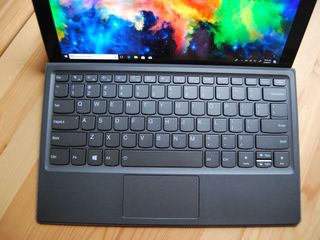
The keys are a good size, nicely spaced, and have a lot of travel, and you won't mind typing for lengthy periods of time. A backlight — either on or off — comes in handy when working in the dark. The Precision touchpad, which does track well, is small and I found my fingers going over the edge quite frequently. If you're often pointing, you'll likely ditch the touchpad for the touch display or an external mouse.
Lenovo Miix 520 performance
The eighth-generation Intel CPU delivers four-core performance with just a 15W thermal design point (TDP), but the two-cell 39WHr battery still ran from full to depleted in about five hours when under a regular workload. You can likely get six hours from it if you're careful, but this still isn't enough to get through a workday or even a long flight.
The fan kicks on when you're multi-tasking, but it isn't so loud that it becomes bothersome. There's plenty of venting along the edges, and I didn't find it get very hot at all.
CPU
Geekbench 4.0 Benchmarks (Higher is better)
| Device | CPU | Single core | Multi core |
|---|---|---|---|
| Lenovo Miix 520 | i5-8250U | 4,277 | 12,742 |
| Lenovo Miix 720 | i7-7500U | 3,870 | 7,322 |
| Lenovo Yoga 720 15 | i7-7700HQ | 3,784 | 10,255 |
| Lenovo ThinkPad X1 Yoga (2nd Gen) | i5-7200U | 3,911 | 7,549 |
| Surface Pro | i7-7660U | 4,512 | 9,346 |
| Surface Laptop | i5-7200U | 3,725 | 7,523 |
| Lenovo ThinkPad T470 | i5-7300U vPro | 4,394 | 8,580 |
| Dell Latitude 5285 | i7-7600U | 4,635 | 9,289 |
| Lenovo ThinkPad X270 | i7-7600U | 4,512 | 8,566 |
| Lenovo ThinkPad T470s | i5-7300U vPro | 3,919 | 6,077 |
| Lenovo Yoga 720 13 | i5-7200U | 3,881 | 7,509 |
| Lenovo X1 Carbon | i5-7300U | 4,139 | 8,311 |
| HP EliteBook x360 G2 | i7-7600U | 4,496 | 8,435 |
| Samsung Notebook 9 15 Ext | i7-7500U | 4,316 | 8,320 |
| Dell Latitude 7280 | i7-7600U | 4,381 | 7,935 |
| Dell XPS 13 (9360) | i7-6560U | 4,120 | 7,829 |
| HP Spectre 13 | i7-7500U | 4,100 | 7,469 |
| Surface Book | i7-6600U | 3,948 | 7,415 |
The eighth-generation Intel Core i5-8250U delivers a lot of power without sucking up much battery. The single-core score competes with most seventh-generation Core i7 CPUs, and when all four cores kick in, this thing can really perform. If you need a device for multi-tasking, the Miix 520 has the hardware.
GPU
Geekbench 4.0 Graphics OpenCL (Higher is better)
| Device | Score |
|---|---|
| Lenovo Miix 520 | 20,548 |
| Lenovo Miix 720 | 19,688 |
| Lenovo Yoga 720 15 | 13,727 |
| Lenovo ThinkPad X1 Yoga (2nd Gen) | 19,738 |
| Surface Pro 2017 | 30,678 |
| Surface Laptop | 19,256 |
| Lenovo ThinkPad T470 | 21,276 |
| Dell Latitude 5285 | 21,921 |
| Lenovo ThinkPad X270 | 17,376 |
| Lenovo ThinkPad T470s | 16,635 |
| Lenovo Yoga 720 13 | 18,185 |
| Lenovo X1 Carbon | 20,932 |
| Dell Latitude 5480 | 21,616 |
| Dell XPS 13 (9360) | 19,410 |
| Surface Book | 18,197 |
| Dell Latitude 7280 | 17,827 |
Integrated Intel UHD Graphics 620 (a rebrand of HD Graphics 620 for the eighth-generation CPUs) handles medium-duty multimedia editing and even some decent gaming. Don't expect a powerhouse in the graphics department and you won't be disappointed.
PCMark
PCMark Home Conventional 3.0
| Device | Score | Comparison |
|---|---|---|
| Lenovo Miix 520 | 3,314 | Better than 66 percent of all results |
| Lenovo Miix 720 | 2,695 | Better than 46 percent of all results |
| Lenovo Yoga 720 15 | 2,993 | Better than 57 percent of all results |
| Lenovo ThinkPad X1 Yoga (2nd Gen) | 2,773 | Better than 46 percent of all results |
| Surface Pro 2017 | 3,055 | Better than 57 percent of all results |
| Surface Laptop | 2,494 | Better than 40 percent of all results |
| Lenovo ThinkPad T470 | 3,103 | Better than 62 percent of all results |
| Dell Latitude 5285 | 3,079 | Better than 57 percent of all results |
| Lenovo ThinkPad X270 | 3,009 | Better than 57 percent of all results |
| Lenovo ThinkPad T470s | 2,576 | Better than 40 percent of all results |
| Lenovo Yoga 720 13 | 2,717 | Better than 46 percent of all results |
| Lenovo X1 Carbon Core i5 | 2,965 | Better than 57 percent of all results |
| Samsung Notebook 9 15 Ext | 2,998 | Better than 57 percent of all results |
| Dell XPS 15 (9560) | 3,534 | Better than 71 percent of all results |
| Dell Latitude 7280 | 2,829 | Better than 52 percent of all results |
| HP Spectre x360 15 | 2,472 | Better than 41 percent of all results |
The PCMark Home Conventional test measures how well a bunch of your hardware works together while performing everyday tasks. The latest CPU, 8GB of DDR4 RAM, and a blazing SSD all contribute to a great score. It will tear through everyday tasks, and might even be at the doorstep of some specialized tasks because of the four cores.
SSD
CrystalDiskMark (Higher is better)
| Device | Read | Write |
|---|---|---|
| Lenovo Miix 520 | 1,845 MB/s | 1,236.2 MB/s |
| Lenovo Miix 720 | 1,183 MB/s | 595.1 MB/s |
| Lenovo Yoga 720 15 | 1,839 MB/s | 1,238 MB/s |
| Lenovo ThinkPad X1 Yoga (2nd Gen) | 1,253 MB/s | 763.6 MB/s |
| Surface Pro | 1,284 MB/s | 963 MB/s |
| Surface Laptop | 423 MB/s | 237 MB/s |
| Lenovo ThinkPad T470 | 1,079 MB/s | 716.1 MB/s |
| Dell Latitude 5285 | 1,300 MB/s | 1,113 MB/s |
| Lenovo ThinkPad X270 PCIe | 1,049 MB/s | 636.9 MB/s |
| Lenovo ThinkPad T470s | 1,557 MB/s | 1,333 MB/s |
| Lenovo Yoga 720 | 1,904 MB/s | 1,169 MB/s |
| Lenovo X1 Carbon | 1,518 MB/s | 1,188 MB/s |
| Samsung Notebook 9 15 Ext | 1,365 MB/s | 1,213 MB/s |
| Razer Blade Pro | 2,571 MB/s | 2,467 MB/s |
| Dell XPS 15 (9560) | 2,207 MB/s | 1,628 MB/s |
| Dell XPS 13 (9360) | 1,287 MB/s | 794 MB/s |
| HP Spectre x360 15 | 1,128 MB/s | 862 MB/s |
Lenovo has gone with a 256GB Samsung PM961 SSD, bringing excellent read and write speeds. Booting Windows, unzipping files, and loading apps should all be noticeably quick. The only issue here is that 25GB of space is partitioned to hold about 1GB of Lenovo drivers. Not a deal breaker, but still an inconvenience when working with just 256GB.
Lenovo Miix 520 review: Conclusion
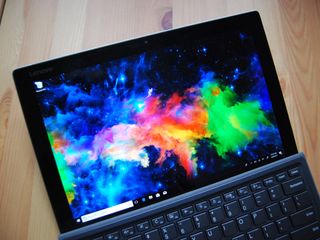
The Miix 520 starts at about $1,000, which isn't a bad price for something with this kind of performance. However, if you can swing an extra $250 and don't need LTE or a quad-core CPU, the Miix 720 has a larger battery, an IR camera for Windows Hello, a higher-resolution display, the same amount of RAM, same size SSD (albeit slower), a Thunderbolt 3 port, and a seventh-generation Core i7 CPU.
While the Miix 520 undoubtedly performs very well in benchmark testing and can chew through most productivity tasks you toss at it, there's not much that really sticks out. The touch display is high-res but has a large bezel and OK color accuracy, the attachable keyboard is comfortable to type on but has too small of a touchpad, and the battery doesn't have enough life to get through a workday.
Pros
- Blazing performance.
- Quality build.
- Comfortable typing.
- Slick watchband hinges.
Cons:
- Poor battery life.
- Small touchpad.
- Hate the pen USB attachment.
- No Windows Hello.

Cale Hunt brings to Windows Central more than eight years of experience writing about laptops, PCs, accessories, games, and beyond. If it runs Windows or in some way complements the hardware, there’s a good chance he knows about it, has written about it, or is already busy testing it.